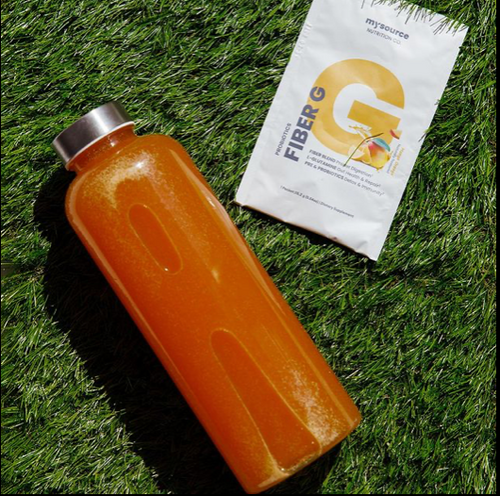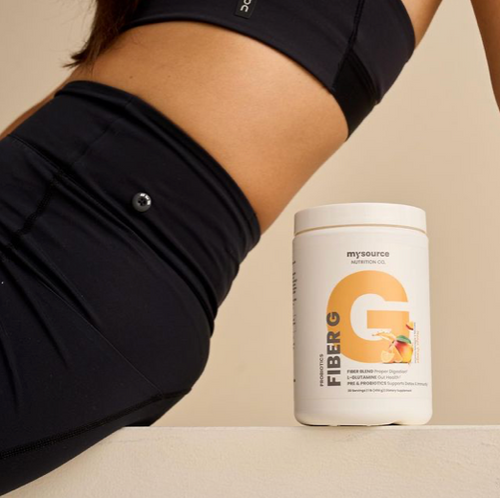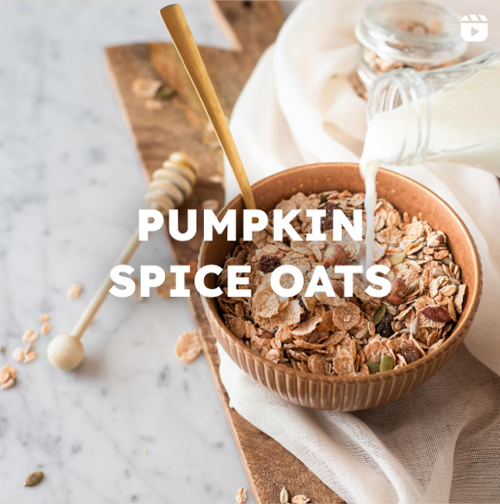Eating high fiber foods has plenty of health benefits. We have put together a list with 26 high fiber vegetables, high fiber fruits and other high fiber foods that can help you lose weight and relieve constipation.
Table of Contents
- What is fiber and why is it important?
- How much fiber do we need a day?
- Top High-Fiber Fruits
- Top High-Fiber Vegetables
- Top High-Fiber Nuts, Seeds & Legumes
- Top High-Fiber Grains
What is fiber and why is fiber important?
Fiber is a type of carbohydrate and the portion of plant-derived foods (fruits, vegetables, nuts, seeds, legumes and grains) that the body can’t digest. High-Fiber foods provide various benefits including:
- Helping you to prevent and relieve constipation
- Promoting the feeling of fullness in between meals
- Helping you to lower LDL Cholesterol
- Helping you to balance blood sugar levels
How much fiber do we need a day?
The recommended daily fiber intake for Women is 21-25 grams, while Men should aim for 30-38 grams a day. Yet, more than 90 percent of women and 97 percent of men do not consume these amounts.
Below you will find several charts of some of the highest fiber foods that you can incorporate daily to boost your total fiber intake.
Top High-Fiber Fruits
Fruits are delicious, rich in vitamins and minerals and a great source of fiber to add to your current diet. However, keep in mind that not all fruits are created equal and have the same benefits and nutritional profile. Below we listed 6 High-Fiber Fruits that will add some extra sweetness to your life, while keeping your digestive system happy and function optimally.

Fig.1
#1 Fiber in Raspberries:
Raspberries are one of the most filling fruits due to its high fiber content. One serving (1 cup) of Raspberries contains only 64 calories and 8g of fiber.Some of the fiber is soluble fiber in the form of pectin, which helps lower cholesterol. Raspberries are also a good source of vitamin C.
#2 Fiber in Avocados:
In addition to providing high levels of several important nutrients and healthy fats, avocados are an excellent source of fiber, particularly when it comes to insoluble fiber. This type of fiber helps to increase the rate at which material moves through the digestive tract, as well as, softens stool to prevent constipation. One half of an Avocado contains around 7g of fiber.
#3 Fiber in Apples:
“An Apple A Day Keeps the Doctor Away”. Apples are a great source of both soluble and insoluble fiber, rich in flavor, low in calories and high in Vitamin C. One medium sized apple contains around 5g of fiber.Note: Make sure to eat your apple with the skin as most of the nutrients and fiber content is found below the skin.
Continue scrolling to see the full list of high-fiber fruits.
| Fruits | Serving Size | Total Fiber | Total Carbs |
| *Raspberries | 1 cup | 8g | 15g |
| *Avocado | ½ medium | 7g | 9g |
| *Apple | 1 medium | 5g | 25g |
| *Blueberries | 1 cup | 4g | 21g |
| *Strawberries | 1 cup | 3g | 12g |
*Low calorie high-volume food
Top High-Fiber Vegetables
Next time you go to the grocery store, make sure to add any of the following high-fiber vegetables to your cart. Not only are these veggies low in calories, but they are also higher in volume which will help you to feel fuller and more satiated in between meals.

Fig.2
#1 Fiber in Artichokes:
With around 7g the amount of fiber in a single, medium sized Artichoke contains nearly ⅓ of your daily fiber needs. The majority of that fiber is insoluble or the type of fiber that stimulates digestion and promotes regularity.
#2 Beets:
One cup of beets provides 4 grams of fiber, particularly insoluble fiber, which helps reduce the risk of constipation and irregularity. The betaine found in beets has also been shown to improve digestion.
#3 Carrots:
Not only are carrots very high in Vitamin A, but they also provide a fair amount of fiber. Most of the fiber in carrots is solublewhich helps to slow down digestion, lower blood sugar levels and feed the gut bacteria in the gut. One serving (1 cup) of carrots contains around 4 g of fiber.
Note: Boil your carrots to increase fiber content.
Continue scrolling to see the full list of high-fiber vegetables.
| Vegetables | Serving Size (Raw) | Total Fiber | Total Carbs |
| *Artichokes | 1 cup | 7g | 13g |
| *Beets | 1 cup | 4g | 10g |
| *Carrots | 1 cup | 4g | 12g |
| *Brussel Sprouts | 1 cup | 3g | 8g |
| *Broccoli | 1 cup | 2.4g | 6g |
| *Cauliflower | 1 cup | 2g | 5g |
*Low calorie high-volume food
Top High-Fiber Nuts, Seeds & Legumes
Consuming heart healthy fats is essential in many ways. However, did you know that some of your favorite high-fat foods contain a good amount of fiber and are low carb at the same time? Well, keep reading to find out which foods in particular you should focus on incorporating into your diet.Note: The foods listed below are higher in fat and calories. Make sure to watch your portion sizes and try to avoid mindless snacking as this behavior quickly adds up in calories.

Fig.3
#1 Fiber in Almonds:
Almonds are not only high in omega-3 fats, protein, and minerals, they also contain varying amounts of soluble fiber. Again, great for improving lipid profile and keeping overall digestion intact. One serving (28g/1oz) of almonds contains around 3.5g of fiber
#2 Fiber in Chia Seeds:
The high soluble fiber content in Chia Seeds is responsible for its gluey texture of moistened chia seeds. Consume more chia seeds if you suffer from constipation or are looking to feel fuller after or in between meals. Foods high in soluble fiber increase feelings of fullness and promote regular digestion. With 10g of fiber per serving (raw) chia seeds are definitely one of the best high fiber foods.
#3 Fiber in Split Peas:
Split peas are delicious and a great way to add additional fiber into your diet. In fact, 1 cup of split peas (uncooked) has 16g of fiber, which almost yields the daily recommended amount of fiber needed per day. Also, split peas are high in protein, low in fat and are a good source of folate, iron, and potassium.
Continue scrolling to see the full list of high-fiber nuts, seeds and legumes.
| Nuts | Serving Size (Raw) | Total Fiber | Total Carbs |
| *Almonds | 28g/1oz | 3.5g | 5g |
| *Pecans | 28g/1oz | 3g | 4g |
| *Peanuts | 28g/1oz | 2.4g | 4.6g |
| Seeds | Serving Size (Raw) | Total Fiber | Total Carbs |
| Chia Seeds | 1oz | 10g | 12g |
| Flaxseeds | 2 tbsp | 6g | 8g |
| Legumes | Serving Size (Raw) | Total fiber | Total Carbs |
| Split peas | ½ cup | 8g | 20g |
| Navy Beans | ½ cup | 6g | 17g |
| Black Beans | ½ cup | 6g | 23g |
| Pinto Beans | ½ cup | 4.6g | 22g |
*High calorie low-volume food
Top High-Fiber Grains
Last, but not least, let us shed some light on the good old grains. Although this food group doesn’t have the best reputation among dieters, whole grains do contain a significant amount of fiber.Note:Just like with any other foods, portion control is key when incorporating these foods into your daily diet.

Fig.4
#1 Fiber in Barley:
Barley is an excellent source of dietary fiber, but also contains other essential minerals, including magnesium, manganese, and selenium. Compared to whole-grain oats, barley has more dietary fiber and is lower in fat and calories. One serving (½ cup) of barley contains around 7g of total fiber.
#2 Fiber in Quinoa:
With 6g in fiber per serving size (1 cup) Quinoa is much higher in fiber than most grains. Most of the fiber contained is insoluble, helping move food along the digestive tract and help keeping you regular. Quinoa is also a complete protein and contains all 9 essential amino acids. It is also a gluten-free grain and high in minerals.
#3: Whole Wheat Pasta:
Next time you crave pasta, opt for whole wheat pasta. Whole wheat pasta is 60% higher in fiber and 30% lower in calories than regular pasta. It is a great source of insoluble fiber, helping your digestive system to pass food along your system. One serving (1cup) of barley contains around 7g of total fiber.
Continue scrolling to see the full list of all high-fiber grains.
| Grains | Serving Size (Cooked) | Total Fiber | Total Carbs |
| Barley | ½ cup | 7g | 30g |
| Quinoa | 1 cup | 6g | 39g |
| Whole Wheat Pasta | 1 cup | 6g | 49g |
| *Oats | ½ cup (uncooked) | 4g | 27g |
| *Popcorn | 4 cups | 3g | 15g |
*Low calorie high-volume food
Sources:
- Bjarnadottir, Adda. “Carrots 101: Nutrition Facts and Health Benefits.”Healthline, Healthline Media, 3 May 2019, www.healthline.com/nutrition/foods/carrots#:~:text=6%20%2C%207%20).
- Dreher, Mark L, and Adrienne J Davenport. “Hass Avocado Composition and Potential Health Effects.”Critical Reviews in Food Science and Nutrition, Taylor & Francis, 2013, www.ncbi.nlm.nih.gov/pmc/articles/PMC3664913/.
- Fiber content of foods in common portions. Harvard University Health Services. Website: http://huhs.harvard.edu/assets/File/OurServices/Service_Nutrition_Fiber.pdf. Accessed December 10, 2015.
- UCSF Health. “Increasing Fiber Intake.”Ucsfhealth.Org, 22 June 2021, www.ucsfhealth.org/education/increasing-fiber-intake#:%7E:text=Total%20dietary%20fiber%20intake%20should,about%20half%20the%20recommended%20amount.
Welcome to MySource Nutrition
We are happy to welcome you to our community. Say goodbye to occasional constipation, bloating, sugar cravings and other gut related issues with MySource's Fiber G.







